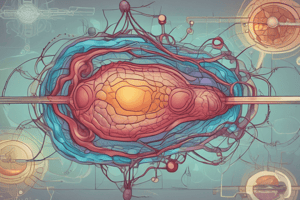Podcast
Questions and Answers
What percentage of fatty acids undergo beta-oxidation in the liver?
What percentage of fatty acids undergo beta-oxidation in the liver?
- 95
- 85
- 80 (correct)
- 90
What is the name of the lipoprotein that has a very low density?
What is the name of the lipoprotein that has a very low density?
- HDL
- LDL
- VLDL (correct)
- IDL
Where does citrate play a role in the regulation of fatty acid synthesis?
Where does citrate play a role in the regulation of fatty acid synthesis?
- Golgi apparatus
- Cytoplasm
- Endoplasmic reticulum
- Mitochondria (correct)
What is the name of the process by which glycogen is converted to glucose?
What is the name of the process by which glycogen is converted to glucose?
What is the name of the molecule that is involved in the transport of fatty acids into the mitochondria?
What is the name of the molecule that is involved in the transport of fatty acids into the mitochondria?
What is the role of UDP glucose pyrophosphorylase in glycogen synthesis?
What is the role of UDP glucose pyrophosphorylase in glycogen synthesis?
What is the function of glycogenin in glycogen synthesis?
What is the function of glycogenin in glycogen synthesis?
What type of bond is formed between glucose residues in a glycogen primer?
What type of bond is formed between glucose residues in a glycogen primer?
What is the role of glycogen synthase in glycogen synthesis?
What is the role of glycogen synthase in glycogen synthesis?
Why is a branching enzyme necessary in glycogen synthesis?
Why is a branching enzyme necessary in glycogen synthesis?
What is the minimum number of glucose residues required for branching to occur in glycogen synthesis?
What is the minimum number of glucose residues required for branching to occur in glycogen synthesis?
What is the result of the branching enzyme's action in glycogen synthesis?
What is the result of the branching enzyme's action in glycogen synthesis?
What is the linkage formed between glucose units added by glycogen synthase?
What is the linkage formed between glucose units added by glycogen synthase?
What is the structure of glycogenin?
What is the structure of glycogenin?
What is the role of UDP-glucose in glycogen synthesis?
What is the role of UDP-glucose in glycogen synthesis?
Flashcards are hidden until you start studying
Study Notes
Non-Carbohydrate Precursors of Glucose
- Amino acid catabolism is the main source of pyruvate and oxaloacetate for gluconeogenesis during fasting or carbohydrate starvation.
- Muscle proteins break down to supply amino acids, which are transported to the liver and deaminated to gluconeogenesis inputs.
- Glycerol, derived from hydrolysis of triacylglycerols in fat cells, is also a significant input to gluconeogenesis.
Bypass of Irreversible Steps in Glycolysis
- In gluconeogenesis, three reactions are bypassed by a set of separate enzymes.
- The bypass of pyruvate kinase involves two enzymes: pyruvate phosphoenoenolpyruvate and phosphoenolpyruvate carboxy kinase.
- Carboxylation occurs in the mitochondria, where pyruvate is converted to oxaloacetate by pyruvate carboxylase, requiring biotin and ATP.
- The oxaloacetate is then transported from the mitochondria to the cytosol using the malate-aspartate shuttle.
Conversion of Oxaloacetate to Glucose
- Oxaloacetate is converted to 3-phosphoglycerate, which is then converted to glyceraldehyde-3-phosphate.
- Two molecules of glyceraldehyde-3-phosphate combine to form fructose-1,6-bisphosphate, which is then converted to fructose-6-phosphate and glucose-6-phosphate.
- Glucose-6-phosphate is isomerized to glucose-6-phosphate by phosphohexo isomerase.
- Glucose-6-phosphate is hydrolyzed to free glucose by glucose-6-phosphatase, mainly in the liver.
Significance of Gluconeogenesis
- Only the liver can replenish blood glucose through gluconeogenesis, maintaining blood glucose levels.
- Gluconeogenesis maintains blood glucose levels during starvation, when glycogen stores are depleted.
- The process requires energy, with 6 ATPs required to generate one glucose molecule.
- Hormones like glucagon and glucocorticoids increase gluconeogenesis, while insulin inhibits it.
Glycogen Metabolism
- Glycogen is a highly branched glucose polymer, stored in the liver and muscle.
- Liver glycogen provides glucose during fasting, while muscle glycogen acts as a reserve fuel for muscle contraction.
- Glycogen degradation (glycogenolysis) involves phosphorolysis, debranching, and glycogen phosphorylase.
Glycogen Synthesis and Degradation
- Glycogen synthesis involves glycogenin, UDP glucose, and glycogen synthase.
- Glycogen degradation involves glycogen phosphorylase, debranching enzymes, and glycogen synthase.
- Regulation of glycogen metabolism involves carbohydrates, fatty acids, protein, and hormonal balance.
Studying That Suits You
Use AI to generate personalized quizzes and flashcards to suit your learning preferences.




